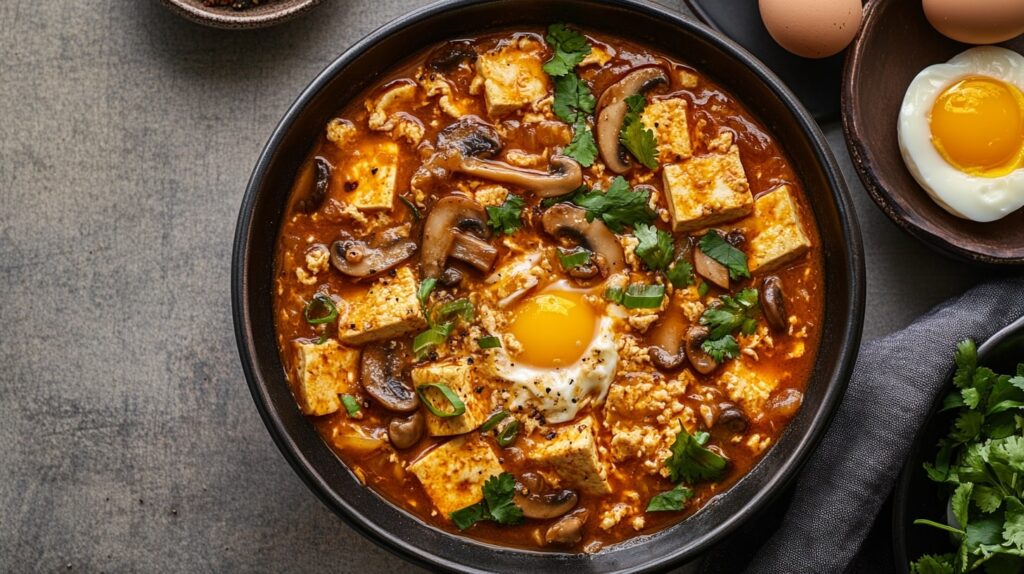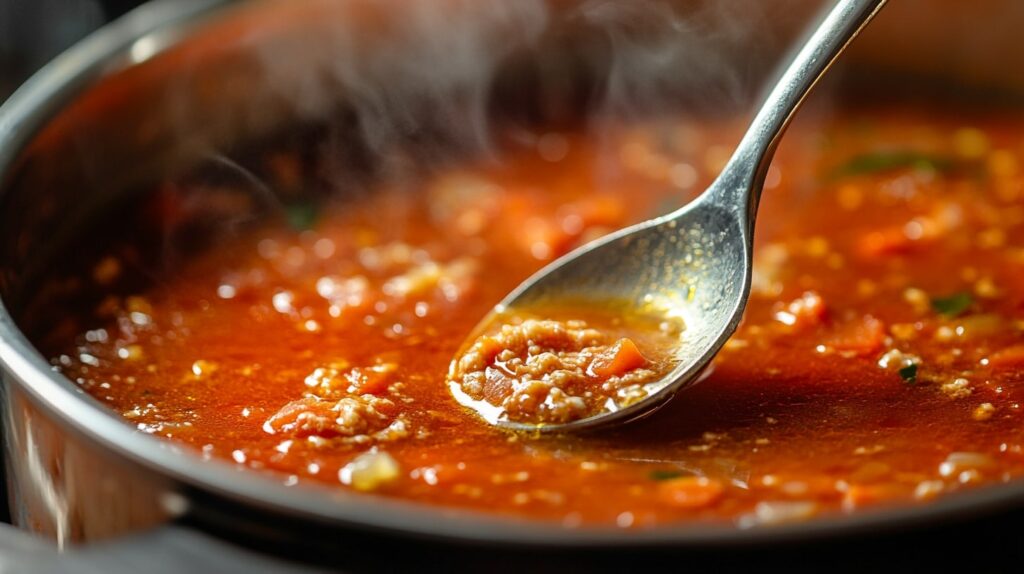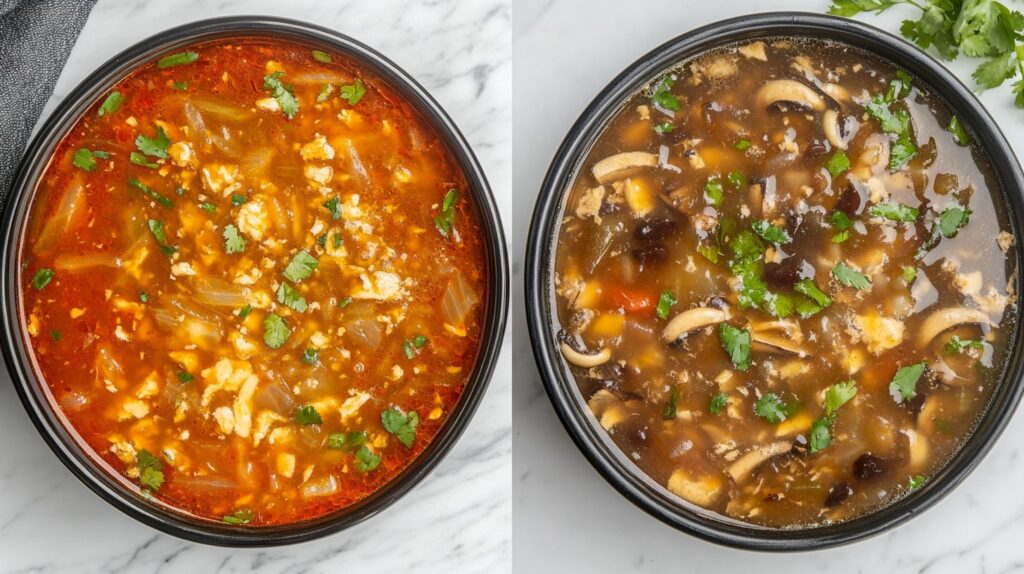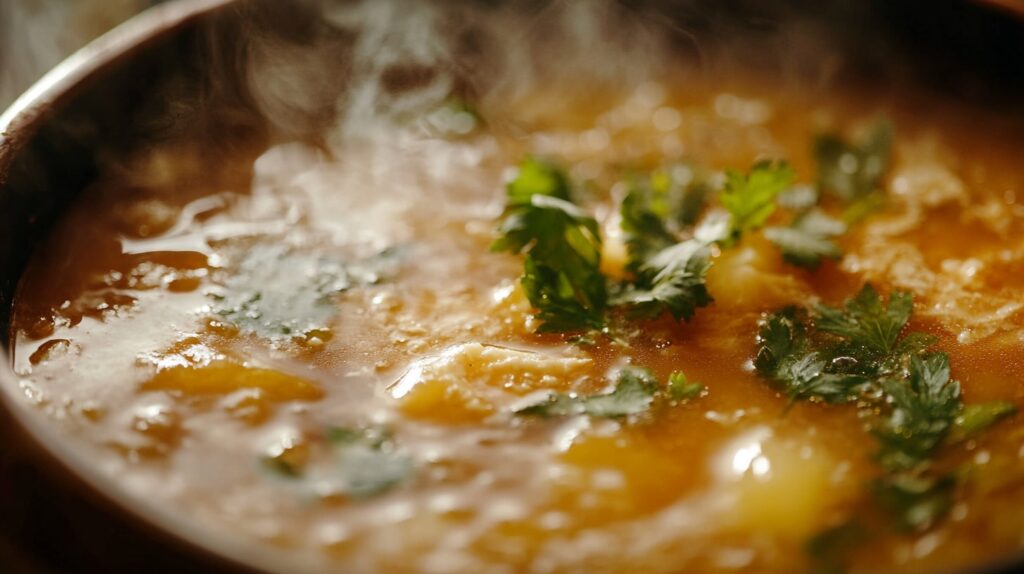
Hot and sour soup is a flavorful, comforting dish that many people love, especially during cold weather or when battling a sore throat. One of the soup’s standout characteristics is its unique thick consistency. Have you ever wondered, “Why is hot and sour soup thick?” 🤔 Let’s dive deep into the magic behind that thick, satisfying texture. We’ll cover the science, common thickening problems (and their fixes), cultural variations, and some tips to help you make the perfect hot and sour soup every time!
Table of contents
Understanding Hot and Sour Soup 🥢
Origins and Cultural Significance of Hot and Sour Soup 🌏
Hot and sour soup has its roots in Chinese cuisine. Originating from regions like Sichuan and Beijing, this soup has traveled the globe and evolved along the way. Each culture adds its own twist, but the foundation remains the same: a tantalizing mix of spicy, sour, and savory flavors.
Why do people love it so much? Aside from its taste, the thick texture adds a sense of richness that makes it feel more like a meal than a simple broth. It’s a go-to dish for people recovering from colds, needing a warm comfort food, or just craving a burst of bold flavors.
Key Ingredients in Hot and Sour Soup 🧾
The beauty of hot and sour soup lies in its simple yet powerful ingredients. Let’s break them down:
| Ingredient | Purpose |
|---|---|
| Tofu | Adds protein and texture |
| Mushrooms | Earthy flavor, chewy texture |
| Eggs | Swirled for richness |
| Pork or Chicken | Adds meatiness |
| Bamboo Shoots | Crunchy texture |
| Black Vinegar | Gives the sour kick |
| White Pepper | Adds heat and spice |
| Soy Sauce | For umami flavor |
| Cornstarch | The magic thickener! 🌟 |
Of course, you can tweak the ingredients to match your preferences. Some versions are vegetarian or vegan, while others pack in a lot of meat. But one thing stays consistent: that thick texture.
The Science Behind the Thickness of Hot and Sour Soup 🔬

So, what makes hot and sour soup thick? Let’s explore the science behind it.
Role of Starch in Thickening Soups 📚
The key to a thick hot and sour soup is starch, specifically cornstarch. Cornstarch is a thickening agent that’s commonly used in Asian cooking. When you add cornstarch to a hot liquid, it absorbs water and swells, creating a gel-like consistency. This process is called gelatinization.
When you see hot and sour soup with that perfect glossy thickness, you can thank cornstarch for working its magic.
“Starch molecules expand like tiny balloons when heated in water, turning your soup from thin and watery to rich and velvety.” 🌟
How Cornstarch Works to Thicken Hot and Sour Soup 🍃
Here’s a simplified breakdown of how cornstarch does its job:
- Mixing the Slurry: Cornstarch needs to be mixed with cold water to create a slurry before adding it to the soup. This prevents it from clumping.
- Heating the Soup: When the slurry is added to the hot soup, the heat causes the starch molecules to absorb water and expand.
- Thickening Action: As the starch molecules expand, they thicken the soup and give it that lovely smooth texture.
Without cornstarch, your hot and sour soup would just be a thin, watery broth. And nobody wants that, right?
Alternative Thickening Agents in Hot and Sour Soup 🌱
While cornstarch is the most common thickener, you might want to try some alternatives. Whether you’re looking for a gluten-free option or just experimenting, here are some substitutes:
| Thickening Agent | Description |
|---|---|
| Potato Starch | Similar to cornstarch but lighter |
| Arrowroot Powder | Great for gluten-free diets |
| Tapioca Starch | Adds a slightly chewy texture |
| Rice Flour | Traditional in some Asian recipes |
Each of these thickening agents works similarly to cornstarch. Just remember to mix them with cold water before adding them to your soup!
Why Do People Prefer Hot and Sour Soup to Be Thick? 🤤
You might be wondering, “Why do people like thick soups so much?” Well, there are a few reasons why thickness is a game-changer for hot and sour soup.
Texture and Mouthfeel Preferences 👅
Let’s face it—texture matters. A thicker soup feels more substantial and satisfying. When you take a spoonful of hot and sour soup and feel that silky smooth texture glide over your tongue, it’s like a warm hug for your taste buds. ❤️
Thin soups can sometimes feel watery or unsatisfying. But a thick soup? That’s like eating a hearty meal in a bowl.
Balancing Flavors with Thickness ⚖️
Hot and sour soup is known for its bold flavors. The thickness helps to balance these strong tastes. Imagine if the soup were thin—the sharp sourness and intense heat might be overpowering. The thick texture mellows out these flavors, giving you a more balanced and enjoyable experience.
“A thick soup is like a cozy blanket that wraps all the flavors together in harmony.” 🧣
Common Problems When Thickening Hot and Sour Soup 😬
Even though thickening soup sounds simple, it can sometimes go wrong. Let’s talk about a few common problems and how to fix them.

Why Is My Hot and Sour Soup Too Thin? 💧
Have you ever finished making your soup, only to find it’s still watery? Don’t worry—it happens to the best of us! Here are some common reasons why your soup might be too thin:
Causes of Thin Soup and How to Fix Them 🛠️
- Not Enough Cornstarch: If you didn’t add enough cornstarch, the soup won’t thicken properly.
- Fix: Make a new cornstarch slurry and slowly add it to the soup while stirring.
- Soup Isn’t Hot Enough: Cornstarch needs heat to activate and thicken.
- Fix: Make sure the soup is simmering when you add the slurry.
- Adding Slurry Too Fast: Dumping in the slurry all at once can prevent proper thickening.
- Fix: Add the slurry slowly, stirring constantly to avoid clumps.
- Too Much Liquid: If you added too much broth, the starch won’t be able to thicken it.
- Fix: Let the soup simmer and reduce for a few minutes to evaporate excess liquid.
Why Is My Hot and Sour Soup Too Thick? 🥣
While having a thick soup is great, sometimes it can end up too thick, almost like a gloopy pudding. This can happen for several reasons, but the good news is it’s usually easy to fix.
How to Adjust Overly Thick Soup 🛠️
If your hot and sour soup resembles more of a paste than a soup, here’s how to save it:
- Add More Broth or Water: The simplest fix is to add a bit more broth or water. Do this gradually so you don’t thin it out too much.
- Tip: Add small amounts of broth and stir well each time. Taste as you go to make sure the flavor stays balanced.
- Add More Vinegar or Soy Sauce: Sometimes, the thick consistency can dull the flavors. Adding a splash of black vinegar or soy sauce can help bring the taste back to life.
- Heat and Stir: If you’ve added too much starch, gently heat the soup while stirring. This can sometimes break down the excess thickener and loosen the texture.
- Add Vegetables or Tofu: Adding extra ingredients like tofu, mushrooms, or bamboo shoots can help distribute the thickness and balance it out.
“Remember, when thickening soup, it’s always easier to add more starch than to fix an overly thick soup.” ⏳
The Proper Technique for Thickening Hot and Sour Soup 🥄
Getting the perfect thickness for your hot and sour soup isn’t just about the ingredients—it’s about the technique. Let’s go through the steps to ensure your soup turns out just right.
Step-by-Step Guide to Adding Starch Correctly 📋
- Make a Slurry: In a small bowl, mix 2 tablespoons of cornstarch with 4 tablespoons of cold water. Stir until smooth.
- Tip: Always use cold water to avoid clumps.
- Bring the Soup to a Simmer: Make sure your soup is simmering, not boiling. Boiling can break down the starch and cause the soup to lose thickness.
- Add the Slurry Slowly: While stirring the soup with one hand, pour the slurry in slowly and steadily with the other. This helps distribute the starch evenly.
- Stir Constantly: Keep stirring as you add the slurry to avoid any clumps forming.
- Simmer for 1-2 Minutes: Let the soup cook for a minute or two to allow the starch to fully activate and thicken the soup. If it’s still not thick enough, you can add more slurry.
- Check the Consistency: If it looks perfect, you’re done! If it’s too thin, add more slurry. If it’s too thick, add a bit more broth.
Tips to Avoid Lumps When Thickening Soup 🥄❌
Lumpy soup can ruin the texture. Here are some tips to ensure your soup stays smooth and velvety:
- Always Mix the Slurry Well: Make sure your cornstarch and water are thoroughly mixed before adding.
- Add Slurry to Hot Soup: Cornstarch thickens best when added to hot liquid.
- Stir Constantly: Stirring helps distribute the starch evenly and prevents clumping.
- Don’t Add Cornstarch Directly to the Soup: Always mix it with water first to create a slurry.
How to Achieve the Perfect Thickness Every Time 🎯
Consistency is key when making hot and sour soup. Follow these tips to nail the thickness every time you cook.
Using the Right Starch-to-Liquid Ratio 📏
A good rule of thumb is:
- 1 tablespoon of cornstarch for every 1 cup of broth.
This ratio typically results in a soup that’s thick enough to coat a spoon but not overly gloopy.
Controlling Thickness by Adjusting Heat and Timing ⏰
- Low Heat for Thicker Texture: Letting the soup simmer gently after adding the slurry helps it thicken gradually.
- Avoid Boiling: Boiling can break down the starch and thin out the soup.
- Check Frequently: Soup can thicken quickly, so keep an eye on it and adjust as needed.
“Patience is key! Let the soup simmer slowly, and you’ll be rewarded with the perfect velvety texture.” 🍲✨
How Different Cultures Tackle Soup Thickness 🌍
Different regions have their own spin on hot and sour soup, and this can affect how thick the soup is. Let’s explore a few variations!
Chinese vs. Western Approaches to Soup Thickening 🥢🍽️
- Chinese Version: Traditional Chinese hot and sour soup relies heavily on cornstarch for that glossy, thick texture. It often includes ingredients like tofu, mushrooms, bamboo shoots, and pork.
- Western Adaptations: In Westernized versions, chefs might use flour or other thickeners to achieve a similar texture. Some versions even skip thickening altogether for a lighter broth.
Regional Variations of Hot and Sour Soup Thickness 🌏
- Sichuan Style: Known for its bold, spicy flavors, Sichuan hot and sour soup often uses a bit more cornstarch to balance out the heat.
- Cantonese Style: This version is typically lighter and may not be as thick, focusing more on the delicate balance of flavors.
- Thai Hot and Sour Soup (Tom Yum): Unlike its Chinese counterpart, Tom Yum is usually thin and brothy, relying on herbs and spices for flavor instead of thickness.
Healthy Alternatives for Thickening Hot and Sour Soup 🥦
Looking to make a healthier or gluten-free version of hot and sour soup? There are plenty of options for thickening without cornstarch.
Gluten-Free Thickening Options 🌾❌
- Arrowroot Powder: This gluten-free thickener works similarly to cornstarch and gives the soup a clear, glossy finish.
- Potato Starch: Another great gluten-free option, potato starch can thicken soups without altering the flavor.
Low-Carb Thickening Solutions 🥑
- Xanthan Gum: A little goes a long way! This low-carb thickener can create a smooth texture without adding carbs.
- Blended Vegetables: Pureeing some of the soup’s ingredients, like mushrooms or tofu, can naturally thicken the broth.
“Healthy alternatives let you enjoy the richness of hot and sour soup without any guilt!” 🥦💪
Common Myths About Thickening Hot and Sour Soup 🧐
Let’s debunk some popular myths about thickening soup!
Does More Starch Always Mean Thicker Soup? ❓
Nope! Adding too much starch can make your soup gloopy and unpleasant. Stick to the recommended ratios for the best results.
Does Boiling Longer Make Soup Thicker? ⏳
Actually, the opposite can happen. Boiling for too long can break down the starch and make your soup thinner.
Frequently Asked Questions (FAQs) 🤔
You’ve made it this far! Let’s tackle some of the most common questions people have about hot and sour soup and how to get the perfect thick consistency.
Can I Thicken Hot and Sour Soup Without Cornstarch? 🌱
Absolutely! While cornstarch is the traditional thickener, you can use alternatives like:
- Arrowroot Powder: A gluten-free option that gives a similar glossy finish.
- Potato Starch: Great for a lighter, smoother consistency.
- Tapioca Starch: Adds a slightly chewy texture if you want something different.
- Blended Vegetables: Pureeing some of the soup’s ingredients like mushrooms or tofu naturally thickens the soup.
What Makes Restaurant Hot and Sour Soup Perfectly Thick? 🍽️
Ever wondered why the hot and sour soup at your favorite Chinese restaurant is always perfectly thick and glossy? Here’s the secret:
- Precision with Starch: Professional chefs know the exact ratio of cornstarch to broth for that perfect texture.
- High-Quality Ingredients: Using fresh ingredients like mushrooms, bamboo shoots, and quality broth makes a big difference.
- Timing: Adding the cornstarch slurry at the right moment and simmering just enough helps achieve the ideal thickness.
- Proper Technique: Chefs often add the slurry slowly while constantly stirring, preventing any lumps.
“Practice makes perfect! Don’t be afraid to experiment to get that restaurant-quality texture at home.” 👨🍳
Is There a Vegan Option for Thickening Hot and Sour Soup? 🥦
Yes! Hot and sour soup is easy to make vegan, and you can still achieve that lovely thick texture. Here’s how:
- Use Vegetable Broth: Instead of chicken or pork broth.
- Replace Eggs: Skip the egg or use a vegan egg substitute for that swirly texture.
- Thicken with Arrowroot or Tapioca Starch: These are plant-based and work just like cornstarch.
Add plenty of mushrooms, tofu, and bamboo shoots for flavor and texture!
How Can I Prevent My Soup from Becoming Too Gelatinous? 🥣❌
If your soup ends up with a weird, jelly-like texture, it’s likely because:
- Too Much Starch: Adding too much cornstarch can turn your soup into a gooey mess.
- Fix: Use the recommended 1 tablespoon of cornstarch per 1 cup of broth.
- Boiling After Thickening: Boiling the soup after adding the slurry can break down the starch and make it weirdly thick.
- Fix: Simmer gently after adding the slurry, but avoid a rolling boil.
- Reheating Incorrectly: Reheating thickened soup can sometimes make it too thick.
- Fix: Add a bit of broth or water when reheating to loosen it up.
Can You Freeze Hot and Sour Soup? ❄️
Yes, but with a few caveats. Freezing soups with cornstarch can sometimes cause the texture to change. Here are some tips:
- Freeze Before Thickening: If you plan to freeze the soup, skip adding the cornstarch. You can add the slurry when you reheat it.
- Reheat Gently: Thaw the soup overnight in the fridge and reheat slowly on the stovetop. Add a fresh cornstarch slurry for thickness.
“Freezing soup? Hold off on the thickening until you’re ready to eat!” 🥶
Troubleshooting Guide for Hot and Sour Soup 🛠️
Still having issues with your hot and sour soup? Here’s a quick troubleshooting guide to help you out.
| Problem | Cause | Solution |
|---|---|---|
| Soup Too Thin | Not enough starch or not hot enough | Add more slurry and simmer gently |
| Soup Too Thick | Too much starch | Add more broth or water |
| Lumpy Soup | Slurry not mixed well or added too fast | Mix slurry well and add slowly |
| Gelatinous Texture | Boiled too long after thickening | Simmer gently and avoid overboiling |
| Flavor Too Bland | Too much thickener dulling flavors | Add more vinegar, soy sauce, or pepper |
This guide can help you fix any issue you encounter with your soup. Remember, cooking is a learning process, and even the best chefs run into problems sometimes!
Related Recipes You Might Love 🍽️
Looking to explore more comforting soups and helpful cooking guides? Here are some hand-picked recipes and tips to expand your culinary skills:
- Discover the secrets of comfort food classics with The Ultimate Chicken Dumpling Soup Recipe — rich, hearty, and satisfying! 🥣
- Curious about other soup traditions? Try The Ultimate Guide to Egusi Soup for a taste of African flavors. 🌍
- Want to perfect your gravy game? Check out The Ultimate Guide to Beef Gravy Recipe for tips on achieving silky, savory gravy. 🍖
- Explore quick and easy recipes with Chicken and Dumplings with Tortillas for a unique twist on a classic dish. 🌟
Conclusion: Mastering the Perfect Thick Hot and Sour Soup 🥣✨

Hot and sour soup is more than just a dish—it’s a comforting experience, rich in flavor and texture. The magic of this soup lies in its perfectly balanced thickness, which can be achieved with a little knowledge and the right techniques.
Let’s recap the key points to remember:
- Starch is Your Friend: Cornstarch (or alternatives like arrowroot and potato starch) is the secret to that silky, thick consistency.
- Technique Matters: Always make a slurry, add it slowly, and stir constantly to avoid lumps.
- Balance is Key: The thickness enhances the flavors, but too much or too little can throw it off.
- Fixes Are Easy: Whether your soup is too thick, too thin, or lumpy, there’s always a solution.
Now that you’re armed with these tips and tricks, you can confidently whip up a hot and sour soup that rivals any restaurant’s version. So, get out that pot, gather your ingredients, and enjoy the wonderful world of hot and sour soup! 🍲❤️
“Cooking is like art, and every bowl of soup is a masterpiece waiting to be created.” 🎨🥣
